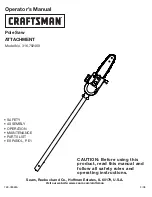
24
•
While making a bevel cut keep hands out of the
path of the blade.
The angle of the blade may confuse
the operator as to the actual blade path while cutting
and contact with the blade will result in serious per-
sonal injury.
•
The blade should not be raised until it has come to
a complete stop.
During a bevel cut the piece cut off
may come to rest against the blade. If the blade is
raised while it is rotating the cut-off piece maybe
ejected by the blade causing the material to fragment
which may result in serious personal injury.
NOTICE:
• When pressing down the handle, apply pressure in par-
allel with the blade. If a force is applied perpendicularly
to the turn base or if the pressure direction is changed
during a cut, the precision of the cut will be impaired.
• Before bevel-cutting, an adjustment of the upper fence
and lower fence maybe required. Refer to the section
titled “Guide fence adjustment”.
5.
Compound cutting
Compound cutting is the process in which a bevel angle
is made at the same time in which a miter angle is being
cut on a workpiece. Compound cutting can be performed
at the angle shown in the table.
009713
When performing compound cutting, refer to “Press cut-
ting”, “Slide cutting”, “Miter cutting” and “Bevel cut” expla-
nations.
6.
Cutting crown and cove moldings
Crown and cove moldings can be cut on a compound
miter saw with the moldings laid flat on the turn base.
There are two common types of crown moldings and one
type of cove moldings; 52/38° wall angle crown molding,
45° wall angle crown molding and 45° wall angle cove
molding. See illustrations.
(Fig. 53)
There are crown and cove molding joints which are made
to fit “Inside” 90° corners ((1) and (2) in
Fig. 54 & 55
) and
“Outside” 90° corners ((3) and (4) in
Fig. 54 & 55
).
Measuring
Measure the wall length and adjust workpiece on table to cut wall contact edge to desired length. Always make sure
that cut workpiece length
at the back of the workpiece
is the same as wall length. Adjust cut length for angle of cut.
Always use several pieces for test cuts to check the saw angles.
When cutting crown and cove moldings, set the bevel angle and miter angle as indicated in the table (A) and position
the moldings on the top surface of the saw base as indicated in the table (B).
In the case of left bevel cut
Table (A)
006361
Table (B)
006362
Example:
In the case of cutting 52/38° type crown molding for position (1) in
Fig. 54 & 55
:
• Tilt and secure bevel angle setting to 33.9° LEFT.
• Adjust and secure miter angle setting to 31.6° RIGHT.
• Lay crown molding with its broad back (hidden) surface down on the turn base with its CEILING CONTACT EDGE
against the guide fence on the saw.
• The finished piece to be used will always be on the LEFT side of the blade after the cut has been made.
Miter angle
Bevel angle
Left and Right 0° – 45°
Left and Right 0° – 45°
Molding position
in Fig. 54 & 55
Bevel angle
Miter angle
52/38° type
45° type
52/38° type
45° type
For inside corner
(1)
Left 33.9°
Left 30°
Right 31.6°
Right 35.3°
(2)
Left 31.6°
Left 35.3°
For outside corner
(3)
(4)
Right 31.6°
Right 35.3°
Molding position
in Fig. 54 & 55
Molding edge against guide fence
Finished piece
For inside corner
(1)
Ceiling contact edge should be
against guide fence.
Finished piece will be on the Left
side of blade.
(2)
Wall contact edge should be against
guide fence.
For outside corner
(3)
Finished piece will be on the Right
side of blade.
(4)
Ceiling contact edge should be
against guide fence.
Содержание LS1016L
Страница 2: ...2 1 2 3 4 5 6 2 2 2 5 6 4 7 8 9 4 3 3 1 009483 010593 009485 009486 009488 001538 ...
Страница 5: ...5 21 22 23 24 25 26 A B 34 35 36 35 37 3 38 39 37 19 1 009493 009494 012597 009483 012591 012592 ...
Страница 12: ...12 75 92 96 009516 ...
Страница 151: ...151 ...
Страница 152: ...884886J995 IDE Makita Jan BaptistVinkstraat 2 3070 Belgium Makita Corporation Anjo Aichi Japan www makita com ...
















































